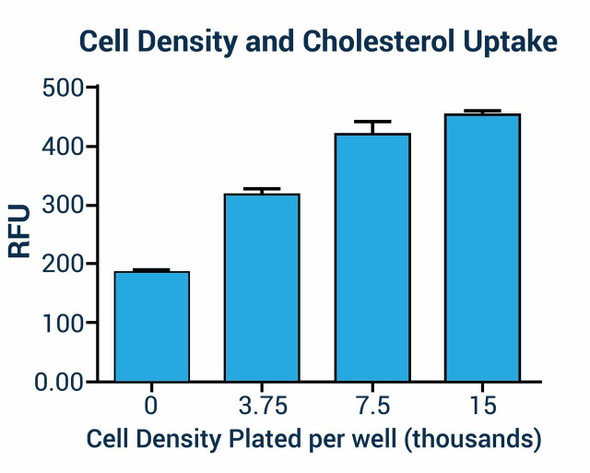

Cholesterol Assay Kit - Information
Assay Genie's Cholesterol Assay (Colorimetric/Fluorometric) uses a single Working Reagent that combines cholesterol ester hydrolysis, oxidation and color reaction in one step. The color intensity of the reaction product at 570nm or fluorescence intensity at Ex/Em = 530/585nm is directly proportional to total cholesterol concentration in the sample.
Applications
For quantitative determination of cholesterol and evaluation of drug effects on cholesterol metabolism.
Cholesterol Assay Kit - Key Features
- Sensitive and accurate. Linear detection range in 96-well plate: 1 to 100 mg/dL cholesterol for colorimetric assays and 0.2 to 10 mg/dL for fluorimetric assays.
- Convenient. Room temperature assay. No 37°C heater is needed.
- High-throughput. Can be readily automated as a high-throughput 96-well plate assay for thousands of samples per day.
Cholesterol Assay Kit - Data Sheet | |
| Kit Includes | Assay Buffer: 20 mL Enzyme Mix: 120 uL Dye Reagent: 120 mL Standard: 1 mL 300 mg/dL cholesterol |
| Kit Requires | Pipetting (multi-channel) devices, 96-well plate and plate reader |
| Method of Detection | OD570nm, or FL530/585nm |
| Detection Limit | OD, FL: 1, 0.2 mg/dL |
| Samples | Serum, plasma etc |
| Species | All |
| Protocol Length | 40 min |
| Size | 100 tests |
| Storage | Store reagents at -20°C |
| Shelf Life | 12 months |
More Details
CHOLESTEROL is a sterol and lipid present in the cell membranes, and is transported in the bloodstream of all animals. It is used to form cell membranes and hormones, and plays important roles in cell signaling processes. Elevated levels (hypercholesterolemia) have been associated with cardiovascular diseases such as atherosclerosis; whereas, low levels (hypocholesterolemia) may be linked to depression, cancer and cerebral hemorrhage. Simple, direct and automation-ready procedures for measuring cholesterol are very desirable.
Citations
| AlTamim et al. | Esculeoside A alleviates reproductive toxicity in streptozotocin-diabetic rats' s model by activating Nrf2 signaling | Saudi Journal of Biological Sciences 2023 | PubMed ID: 37663394 |








